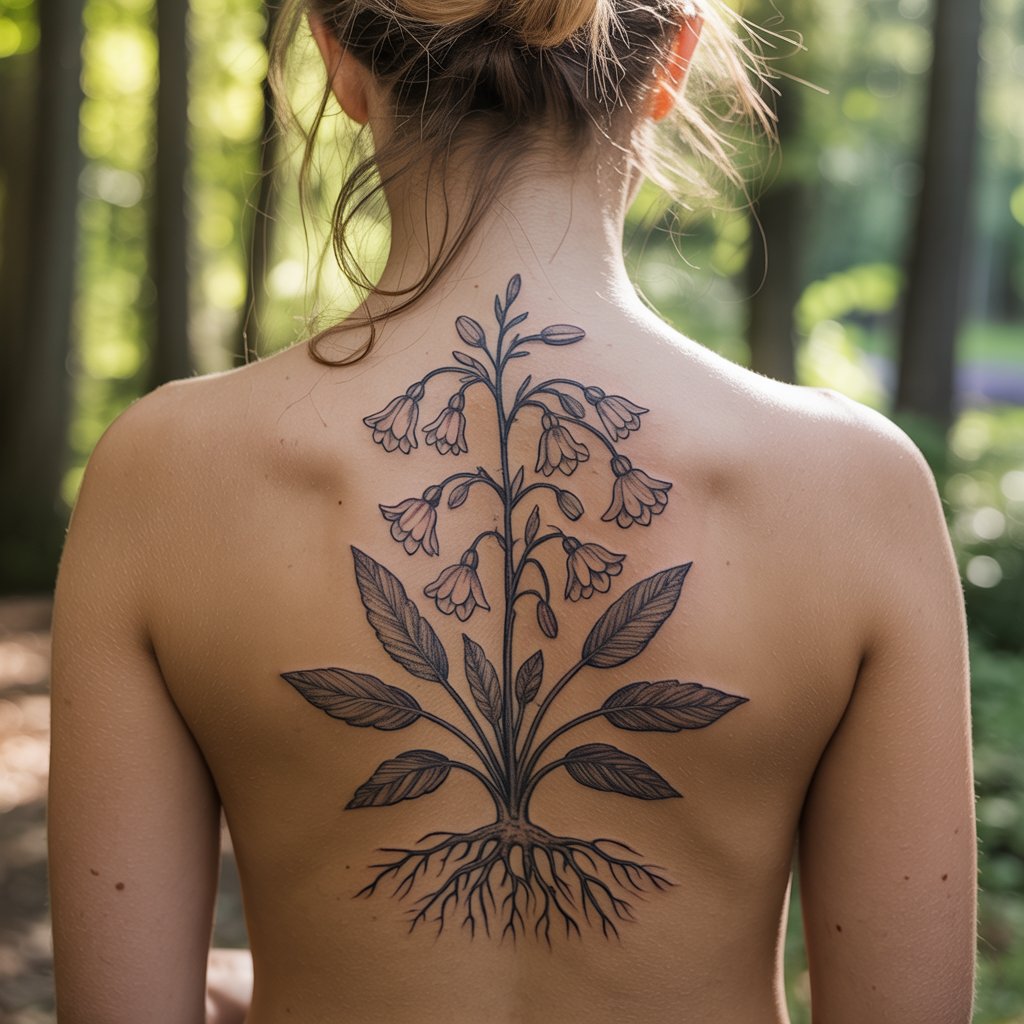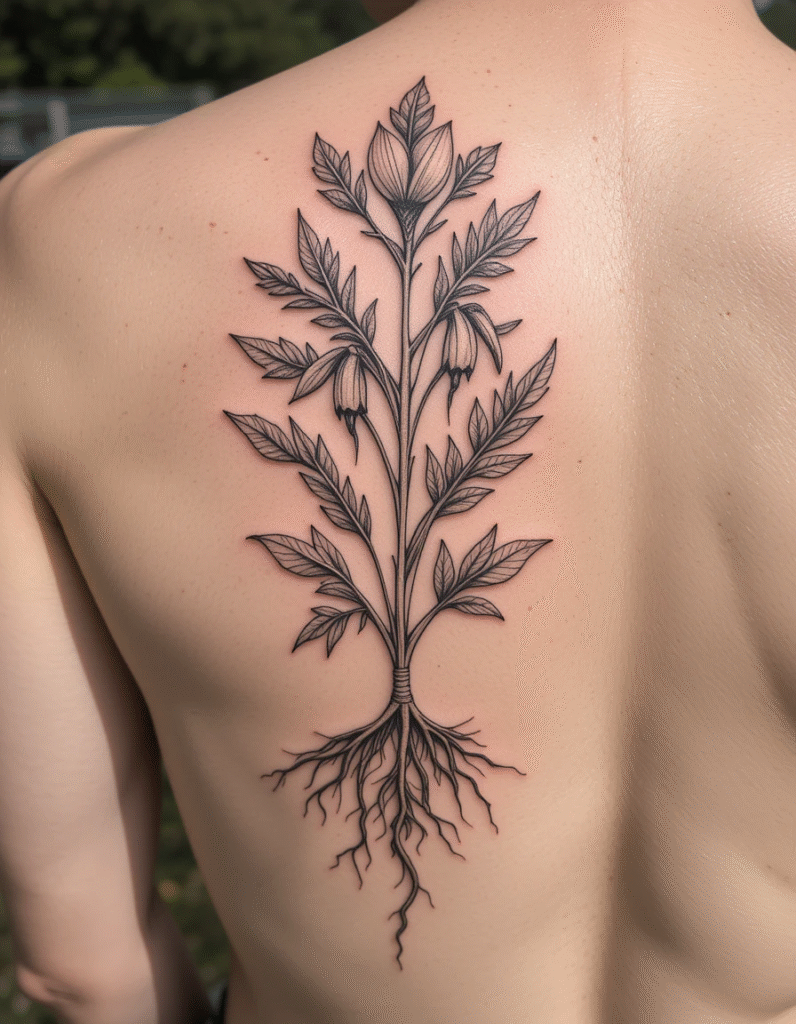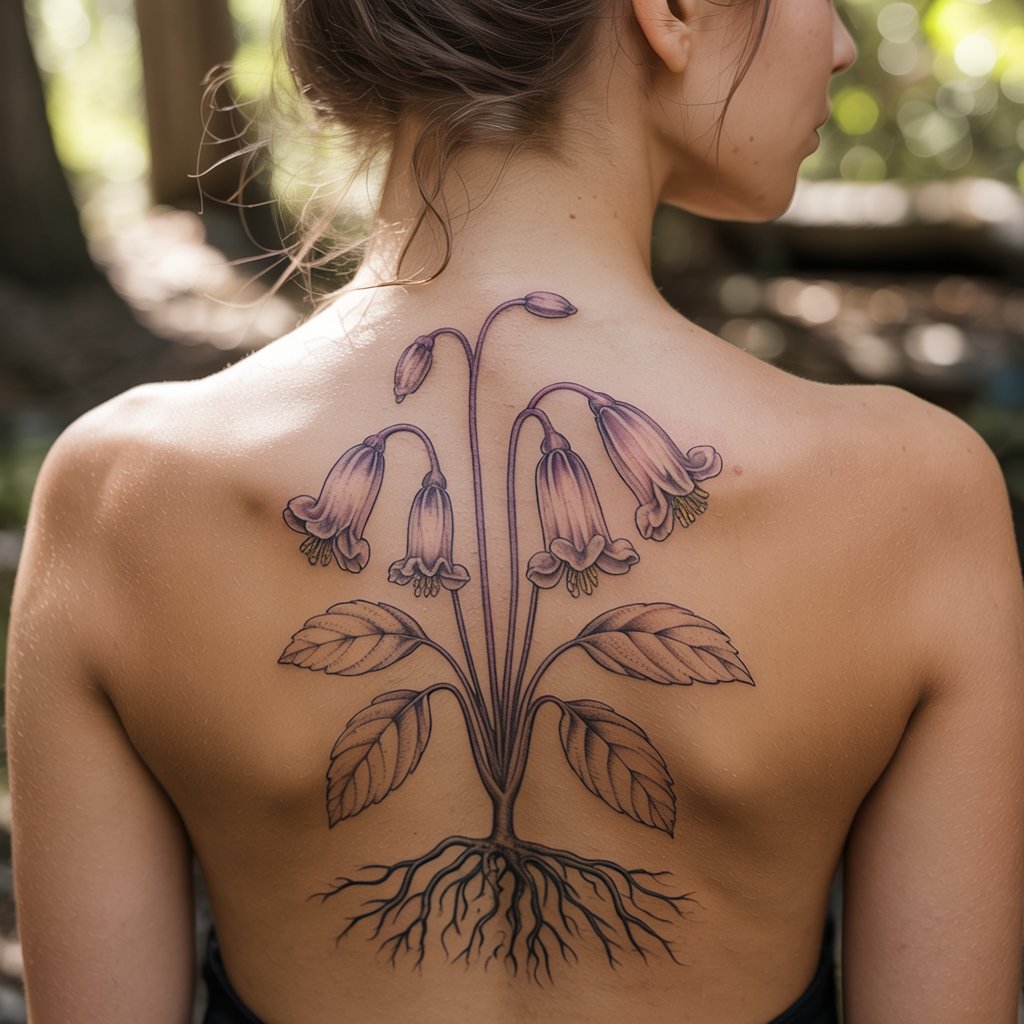The human spine, with its graceful vertical line and natural curves, has emerged as one of the most coveted canvases for botanical tattoo artistry. The delicate floral designs we see gracing this intimate placement represent more than mere decoration—they embody a profound connection between the body’s natural architecture and the organic beauty of the plant world. These stunning spine tattoos featuring drooping bell flowers, intricate leaf work, and symbolic root systems showcase how botanical imagery can transform the back into a living garden of artistic expression.
The Perfect Marriage of Form and Function
The spine’s unique anatomy creates an ideal foundation for vertical botanical compositions that few other body placements can match:
Natural Vertical Flow
The spine’s inherent verticality perfectly complements the upward growth pattern of plants. From delicate root systems spreading at the lower back to flowering blooms reaching toward the neck, these designs follow the body’s natural lines while echoing nature’s own growth patterns. The result is a harmonious integration that feels both intentional and effortless.
Anatomical Elegance
The gentle curves and subtle contours of the spine provide natural breaks and flow points for botanical elements. The shoulder blades create natural framing for larger leaf formations, while the narrow channel of the spine itself becomes the perfect stem or trunk for the overall composition. This anatomical advantage allows artists to create designs that appear to grow organically from the body itself.
Intimate Canvas
Spine tattoos occupy a uniquely personal space—visible when chosen to be revealed, yet easily concealed when privacy is desired. This duality makes botanical spine tattoos perfect for those who want meaningful body art that can transition seamlessly between professional and personal settings.
Botanical Symbolism in Body Art
The choice of botanical imagery for such a significant placement carries deep symbolic weight that resonates across cultures and personal experiences:
Growth and Transformation
Plants represent the ultimate symbol of growth, change, and renewal. A botanical spine tattoo becomes a permanent reminder of personal evolution, with roots representing one’s foundation and origins, while the flowering elements symbolize aspirations and future potential. The spine placement reinforces this symbolism, as the spinal column literally supports our growth and movement through life.
Connection to Earth
In our increasingly digital world, botanical tattoos serve as tangible connections to the natural world. The bell-shaped flowers featured in these designs—reminiscent of bluebells, lily of the valley, or campanulas—evoke peaceful woodland scenes and the quiet beauty of untamed gardens. This connection becomes even more powerful when worn along the spine, our body’s central axis.
Feminine Grace and Strength
While beautiful botanical designs appeal to all genders, there’s an undeniable feminine energy in the flowing, organic forms of flowering plants. The drooping bell flowers particularly embody a gentle strength—delicate in appearance yet resilient in nature. This duality reflects the complexity of feminine power, making these designs particularly meaningful for women seeking to honor both their grace and their strength.
Artistic Techniques That Bring Plants to Life
Creating convincing botanical spine tattoos requires specialized artistic skills and techniques that set them apart from other tattoo styles:
Fine Line Mastery
The delicate nature of botanical subjects demands exceptional fine line work. Each leaf vein, flower petal, and root tendril requires precise needle control and steady hands. The most successful botanical tattoos achieve an almost botanical illustration quality, with line weights that vary naturally to create depth and dimension.
Organic Shading and Texture
Unlike geometric or illustrative styles, botanical tattoos must capture the organic irregularities that make plants feel alive. Artists employ various shading techniques to create the soft transitions found in nature—from the subtle gradients in flower petals to the complex textures of bark and leaves. This organic approach to shading prevents the design from appearing flat or artificial.
Compositional Balance
Perhaps most challenging is creating a composition that flows naturally along the spine’s length while maintaining visual balance. The best botanical spine tattoos feel inevitable—as though the plant simply belongs in that exact configuration. This requires careful planning of how elements scale from roots to flowers, ensuring the design enhances rather than fights the body’s natural proportions.

The Therapeutic Aspect of Botanical Body Art
Beyond their aesthetic appeal, botanical spine tattoos often serve a deeper therapeutic purpose for their wearers:
Healing and Recovery
Many choose botanical imagery during periods of personal healing or recovery. The symbolism of growth through adversity—how plants push through soil, survive harsh conditions, and still manage to bloom—resonates powerfully with those overcoming challenges. The spine placement adds another layer of meaning, as it represents the literal backbone of resilience.
Mindfulness and Presence
The process of researching, designing, and wearing botanical tattoos often encourages a deeper awareness of the natural world. Wearers frequently report increased attention to seasonal changes, plant identification, and gardening interests following their tattoo experience. The permanent art becomes a gateway to ongoing mindfulness practices.
Personal Mythology
Each botanical choice carries personal significance. The bell flowers might represent a childhood garden, a meaningful location, or simply an aesthetic preference that speaks to the soul. Combined with personal elements like specific leaf shapes or root patterns, these tattoos become unique personal mythologies written on the body.
Technical Considerations for Spine Placement
The spine presents unique challenges and considerations that both artists and clients must understand:
Pain and Endurance
Spine tattoos are notorious for their intensity due to the proximity of bone and nerve pathways. The creation of detailed botanical work requires extended sessions, demanding significant pain tolerance. However, many wearers report that the meaningful nature of botanical imagery helps them endure the discomfort.
Healing and Aftercare
The spine’s constant movement during daily activities requires careful attention to healing protocols. The stretching and flexing of back muscles can affect how the tattoo settles, making proper aftercare essential for maintaining the fine details that make botanical tattoos so compelling.
Aging and Longevity
When properly executed and cared for, botanical spine tattoos age gracefully. The organic nature of the subject matter actually benefits from slight softening over time, as it mimics the natural aging process of plants themselves. However, the fine details require initial precision to ensure they remain readable as the tattoo matures.
Cultural Perspectives on Botanical Body Art
The appreciation for botanical tattoos spans cultures and reflects universal human connections to nature:
European Botanical Tradition
The European tradition of botanical illustration, from medieval herbals to Victorian flower catalogs, influences much of contemporary botanical tattooing. The scientific precision combined with artistic beauty found in historical botanical works translates beautifully to skin, creating tattoos that feel both timeless and educational.
Eastern Philosophy Integration
Many wearers incorporate Eastern philosophical concepts into their botanical spine tattoos, viewing the design as a form of personal mandala or meditation focus. The vertical nature of spine placement aligns with concepts of chakras and energy flow, making the tattoo both decorative and spiritually significant.
Contemporary Environmental Consciousness
In our current era of environmental awareness, botanical tattoos often serve as personal statements about ecological values. Choosing to permanently display plant imagery reflects a commitment to celebrating and protecting the natural world, turning the body into a canvas for environmental advocacy.

Choosing Your Botanical Journey
For those inspired to explore botanical spine tattooing, the journey requires careful consideration and planning:
Research and Inspiration
Begin by studying actual botanical specimens, historical botanical illustrations, and contemporary interpretations. Understanding real plant anatomy will help you communicate effectively with your artist and ensure botanical accuracy in your design.
Artist Selection
Seek artists who specialize in botanical work and can demonstrate experience with spine placement. Review portfolios carefully, looking for evidence of fine line work, organic shading, and successful compositional flow along vertical spaces.
Personal Meaning
Consider what aspects of plant life resonate most deeply with your personal journey. Whether drawn to the symbolism of specific flowers, the architectural beauty of leaves, or the hidden strength of root systems, your botanical tattoo should reflect authentic personal connection.
A Growing Art Form
As tattooing continues to evolve and gain mainstream acceptance, botanical spine tattoos represent the sophisticated direction of contemporary body art. They demonstrate that tattoos can be simultaneously beautiful, meaningful, and technically excellent—transcending simple decoration to become personal statements about growth, connection, and the enduring beauty of the natural world.
The delicate bell flowers and graceful botanical compositions adorning spines today will continue inspiring future generations of both tattoo artists and nature lovers. They remind us that our bodies, like gardens, can be cultivated spaces where art and meaning flourish together, creating living testaments to the beauty that surrounds us and grows within us.


